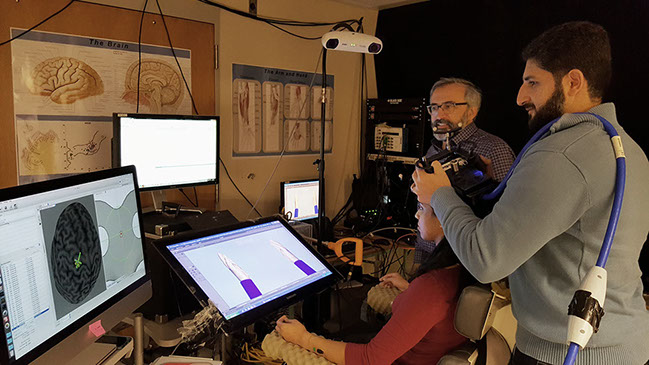

Brain Mapping and Stimulation
Project: Planning and Updating in Frontoparietal Networks for Grasping
Funded by: National Institute of Neurological Disorders and Stroke (NINDS)
Grant: R01 NS085122-02 (Tunik, PI, Adamovich, PI on subcontract), 2/1/14-1/30/18
This project studies the roles of frontoparietal circuits in different stages of sensorimotor integration during goal-directed grasping.
A number of the behavioral sequelae that occur after damage to the brain, such as stroke or traumatic injury, can be explained by abnormalities in the integration of sensory information and motor commands. This project uses brain imaging and non-invasive brain stimulation, combined with novel perturbations of grasping movements with robotics and virtual environments to study the roles played by frontoparietal brain areas in different stages of sensorimotor integration and to identify specific contributions of brain networks subserving goal-directed grasping. The overarching goal of this project is use a healthy-human lesion model to make causal inferences regarding the roles played by frontoparietal cortices in two major stages of sensorimotor integration: during motor planning when visual information of the target goal and haptic information of the hand is transformed into motor commands, and during movement updating when estimates of the sensory consequences of motor commands occur (generation of a forward model). We leverage the time-tested approaches involving perturbations to the target goal and the arm motor plant (perturbations of extrinsic and intrinsic space) that have been used to study sensorimotor integration in the reach system, and apply them to study the grasp circuit, which is controlled by a unique and segregated neural network that is comparatively understudied. This is the first systematic study in humans to test the unique contributions of frontoparietal cortices in planning and forward modeling of hand shape for grasping, and how these processes interact in the context of intrinsic versus extrinsic reference frames. The central goal of Aim 1 is to use functional magnetic resonance imaging (fMRI) to identify the neural bases of motor planning in external vs. internal space and accordingly test the causal involvement of these regions with fMRI-neuronavigated transient lesions elicited with transcranial magnetic stimulation. Aim 2 complements the previous aim by testing the causal involvement of grasp-related frontoparietal areas in online updating of grasp. Here, we leverage multivariate analyses of kinematic responses to novel perturbations of hand configuration and movement goals during grasping to dissociate the involvement of these areas in generation of forward models for hand shape versus integrating sensory information into the motor plan.

2021 Neuromotor Behavior and Neurorehabilitation Lab | New Jersey Institute of Technology





